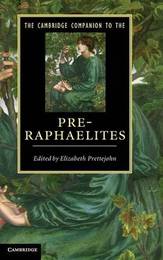
|
The Cambridge Companion to the Pre-Raphaelites
Hardback
Main Details
| Title |
The Cambridge Companion to the Pre-Raphaelites
|
| Authors and Contributors |
Edited by Elizabeth Prettejohn
|
| Series | Cambridge Companions to Literature |
|---|
| Physical Properties |
| Format:Hardback | | Pages:336 | | Dimensions(mm): Height 235,Width 156 |
|
| Category/Genre | Pre-Raphaelite art
Literary studies - c 1800 to c 1900 |
|---|
| ISBN/Barcode |
9780521895156
|
| Classifications | Dewey:709.4109034 |
|---|
| Audience | | Professional & Vocational | | Tertiary Education (US: College) | |
|---|
| Illustrations |
20 Halftones, unspecified
|
|
Publishing Details |
| Publisher |
Cambridge University Press
|
| Imprint |
Cambridge University Press
|
| Publication Date |
30 July 2012 |
| Publication Country |
United Kingdom
|
Description
The group of young painters and writers who coalesced into the Pre-Raphaelite movement in the middle years of the nineteenth century became hugely influential in the development not only of literature and painting, but also more generally of art and design. Though their reputation has fluctuated over the years, their achievements are now recognised and their style enjoyed and studied widely. This volume explores the lives and works of the central figures in the group: among others, the Rossettis, William Holman Hunt, John Everett Millais, Ford Madox Brown, William Morris and Edward Burne-Jones. This is the first book to provide a general introduction to the Pre-Raphaelite movement that integrates its literary and visual art forms. The Companion explains what made the Pre-Raphaelite style unique in painting, poetry, drawing and prose.
Author Biography
Elizabeth Prettejohn is Professor of History of Art at the University of Bristol.
Reviews'Ambitious and challenging, The Cambridge Companion to the Pre-Raphaelites achieves the impossible task of a somewhat comprehensive view of Pre-Raphaelite poetry and painting, thus making a solid contribution to Pre-Raphaelite studies and art history.' Journal of Pre-Raphaelite Studies '... offers eighteen distinct chapters and an introduction by major scholars in the field, the variety of authorship allowing for an unusually full treatment of individual issues and artists. In the case of Dante Gabriel Rossetti and William Morris, there is one chapter on the verse and another on the plastic arts. What emerges is an unusually textured account of a movement and its sources and ramifications.' Jonah Siegal, Victorian Studies
|